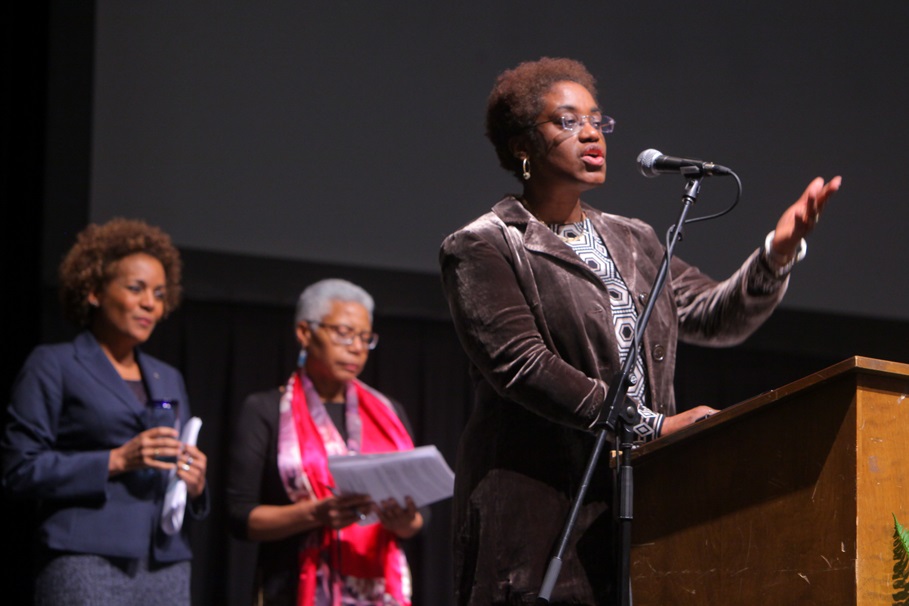
Malinda Smith, with Michaëlle Jean (left) and Jennifer Kelly
20 years ago, political scientist Malinda S. Smith wrote an article in the Edmonton Journal in response to questions in the media about whether we needed Black History Month in Alberta and Canada. It was only last year, on February 1, 2017, that Alberta became the fourth province in Canada to officially recognize Black History Month. As we mark the second anniversary, we revisit Professor Smith's original article which appeared in the Edmonton Journal on March 11, 1998.
Black History Month (BHM) has been subjected to two disparaging columns in the [Edmonton] Journal in recent weeks. It is impossible to address all the misrepresentations in one column, but several criticisms demand a response.
One criticism of BHM associates it with African-American history, and Canadians who observe it are seen as cultural clones. Critics believe the U.S. has "their blacks" and we have "our blacks," and the two histories are separate but equal. The U.S. had slavery, we did not.
Yet, the first recorded sale of a slave in Canada was as early as 1628 when a 10-year-old named Oliver Le Jeune was sold in New France. Most slaves came to Canada directly after capture in Africa or via other British colonies.
Some regulations of slaves, such as the Code Noir, were as harsh as any fugitive law in the U.S. First time offenders lost their ears and had their shoulders branded with a fleur de lys; the second time both legs were removed at the knees; and a third offence elicited death. Precisely because of this brutality, the initial "freedom train" went from British colonies in Canada to the U.S.
Slavery was gradually dismantled in Canada in 1793 first by preventing the acquisition, then by freeing children of slaves at age 25. Slavery was finally abolished in the British Empire, hence Canada, in 1833.
By most accounts, the first recorded black in Canada was one Mathieu Da Costa who in 1609 acted as an interpreter between the French and the MicMac nations. In the 1800s freed blacks arrived in Canada as British Loyalists. One of them, Mary Ann Shadd, was the first Canadian woman to edit a newspaper when she took charge of The Provincial Freemen in 1853.
Most stories of blacks in Canada tend to focus on central and eastern Canada. This does not mean blacks have no history in the West. For example, Mifflin Gibbs was part of the delegation to the 1868 Yale Convention held to persuade British Columbia to join Confederation.
The Calgary cowboy John Ware is often credited with introducing Longhorns into Alberta. Thousands of black homesteaders arrived in Alberta from Oklahoma, Kansas and California in the 1900s and earlier, settling in Amber Valley. Edmontonians were involved in recruiting freed blacks from the American south to live in Peace River and Grand Prairie.
Early efforts were spearheaded by George Washington, Archbishop of St. Mark's Church of the First Born. In August 1920, a Manitoba newspaper characterized the archbishop as "a man who carries on a great deal of missionary and charitable work amongst Negroes around Edmonton, but does not refrain from giving assistance, when necessary, to white folks."
The influx of black homesteaders led to an outcry by white folks in western Canada, and sparked heated debates in Parliament. The opposition of Tory minister W. Thoburn used language similar to the Dixie south: "Would it not be preferable to preserve for the sons of Canada the lands they propose to give to the niggers?"
The Imperial Order of the Daughters of the Empire also objected, claiming "no white woman would be safe" if black men were allowed to emigrate. Then Liberal minister of the interior, Frank Oliver, used more coded language, claiming his government's restrictions were against "undesirable citizens."
Not all parliamentarians and westerners were hostile. Tory minister H.S. Clements characterized his black constituents as "intelligent, respectable and thoroughly good Canadian citizens." And then Tory leader of the Opposition R.L. Borden noted that blacks had been in Canada for over 150 years and they were "good, honest, law-abiding citizens and a credit to the communities in which they live."
The multiple cultures of the African diaspora cannot be divorced from world history, from shared experiences of imperialism, slavery and colonialism, and the shared struggle for freedom and dignity.
Those who attend BHM events learn that the African diaspora in Canada is heterogeneous. They appreciate why we, who are part of the diaspora, refuse to construct arbitrary nationalist walls around blackness. Critics want complex identities to be reduced to racial borders and racial territories. This imposition of "separate but equal" racial identities was repressive when first espoused in the Dixie south. It is still repressive today, despite the fact that it masquerades as an obsequious liberal pluralism.
Malinda S. Smith, Edmonton Journal, March 11, 1998
Read Professor Smith's 2017 interview Making Black History Visible here.
Related: "We Are the Roots: Black Settlers and their Experiences of Discrimination on the Canadian Prairies" (Bailey and Soda Films, 2018)
"Secret Alberta: The Former Life of Amber Valley" (Telus Optik Local, 2017)